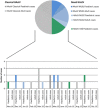Novel and classical human astroviruses in stool and cerebrospinal fluid: comprehensive screening in a tertiary care hospital, Switzerland
- PMID: 28928418
- PMCID: PMC5625321
- DOI: 10.1038/emi.2017.71
Novel and classical human astroviruses in stool and cerebrospinal fluid: comprehensive screening in a tertiary care hospital, Switzerland
Abstract
Classical human astroviruses (HAstV) are the third most common cause of non-bacterial acute gastroenteritis. Due to the lack of routine molecular assays, novel HAstV are underdiagnosed and the magnitude of their contribution to clinical disease remains unknown. To better understand their prevalence and the susceptible patient profile, we conducted a comprehensive screening of novel and classical HAstV in stool and cerebrospinal fluid (CSF) samples collected for clinical care in a tertiary care hospital using a specially designed rRT-PCR panel for the detection of novel (MLB1-3 and VA1-4) and classical HAstV. Of the 654 stool samples, 20 were positive for HAstV, and the novel (n=10; 3 MLB1, 4 MLB2; 3 VA2) and classical (n=10) serotypes were equally prevalent. None of the 105 CSF samples were positive. Investigating the patient profile, we found a higher prevalence (P=0.0002) of both novel and classical HAstV in pediatric stool samples (3.4% and 3%, respectively) compared with adult stool samples (0.5% and 0.7%, respectively). Furthermore, all novel and classical HAstV-positive pediatric subjects were ≤four years old, demonstrating similar susceptible populations. Forty-five percent of positive patients were immunocompromised (novel: 40%, classical: 50%). A comparison of novel and classical HAstV-positive cases showed a lower viral load for novel HAstV (P=0.0007) with significantly more upper respiratory symptoms (70% of subjects; P=0.02); this observation may suggest a unique pathogenic pathway. This study confirms the clinical and epidemiological relevance of novel HAstV and identifies a target population in which routine screening may yield clinically valuable information.
Figures



Similar articles
-
Novel human astroviruses in pediatric respiratory samples: A one-year survey in a Swiss tertiary care hospital.J Med Virol. 2018 Nov;90(11):1775-1778. doi: 10.1002/jmv.25246. Epub 2018 Jul 16. J Med Virol. 2018. PMID: 29905957 Free PMC article.
-
A Spanish case-control study in <5 year-old children reveals the lack of association between MLB and VA astrovirus and diarrhea.Sci Rep. 2020 Feb 4;10(1):1760. doi: 10.1038/s41598-020-58691-3. Sci Rep. 2020. PMID: 32020041 Free PMC article.
-
PCR assays for detection of human astroviruses: In silico evaluation and design, and in vitro application to samples collected from patients in the Netherlands.J Clin Virol. 2018 Nov;108:83-89. doi: 10.1016/j.jcv.2018.09.007. Epub 2018 Sep 13. J Clin Virol. 2018. PMID: 30266005
-
Novel human astroviruses: Novel human diseases?J Clin Virol. 2016 Sep;82:56-63. doi: 10.1016/j.jcv.2016.07.004. Epub 2016 Jul 11. J Clin Virol. 2016. PMID: 27434149 Review.
-
Worldwide prevalence and genotype distribution of human astrovirus in gastroenteritis patients: A systematic review and meta-analysis.Microb Pathog. 2023 Aug;181:106209. doi: 10.1016/j.micpath.2023.106209. Epub 2023 Jun 27. Microb Pathog. 2023. PMID: 37385570 Review.
Cited by
-
Human Astrovirus MLB Replication In Vitro: Persistence in Extraintestinal Cell Lines.J Virol. 2019 Jun 14;93(13):e00557-19. doi: 10.1128/JVI.00557-19. Print 2019 Jul 1. J Virol. 2019. PMID: 31019055 Free PMC article.
-
Beyond Cytomegalovirus and Epstein-Barr Virus: a Review of Viruses Composing the Blood Virome of Solid Organ Transplant and Hematopoietic Stem Cell Transplant Recipients.Clin Microbiol Rev. 2020 Aug 26;33(4):e00027-20. doi: 10.1128/CMR.00027-20. Print 2020 Sep 16. Clin Microbiol Rev. 2020. PMID: 32847820 Free PMC article. Review.
-
Novel human astroviruses in pediatric respiratory samples: A one-year survey in a Swiss tertiary care hospital.J Med Virol. 2018 Nov;90(11):1775-1778. doi: 10.1002/jmv.25246. Epub 2018 Jul 16. J Med Virol. 2018. PMID: 29905957 Free PMC article.
-
Longitudinal Detection of Twenty DNA and RNA Viruses in Allogeneic Hematopoietic Stem Cell Transplant Recipients Plasma.Viruses. 2023 Apr 7;15(4):928. doi: 10.3390/v15040928. Viruses. 2023. PMID: 37112908 Free PMC article.
-
A Spanish case-control study in <5 year-old children reveals the lack of association between MLB and VA astrovirus and diarrhea.Sci Rep. 2020 Feb 4;10(1):1760. doi: 10.1038/s41598-020-58691-3. Sci Rep. 2020. PMID: 32020041 Free PMC article.
References
MeSH terms
LinkOut - more resources
Full Text Sources
Medical
